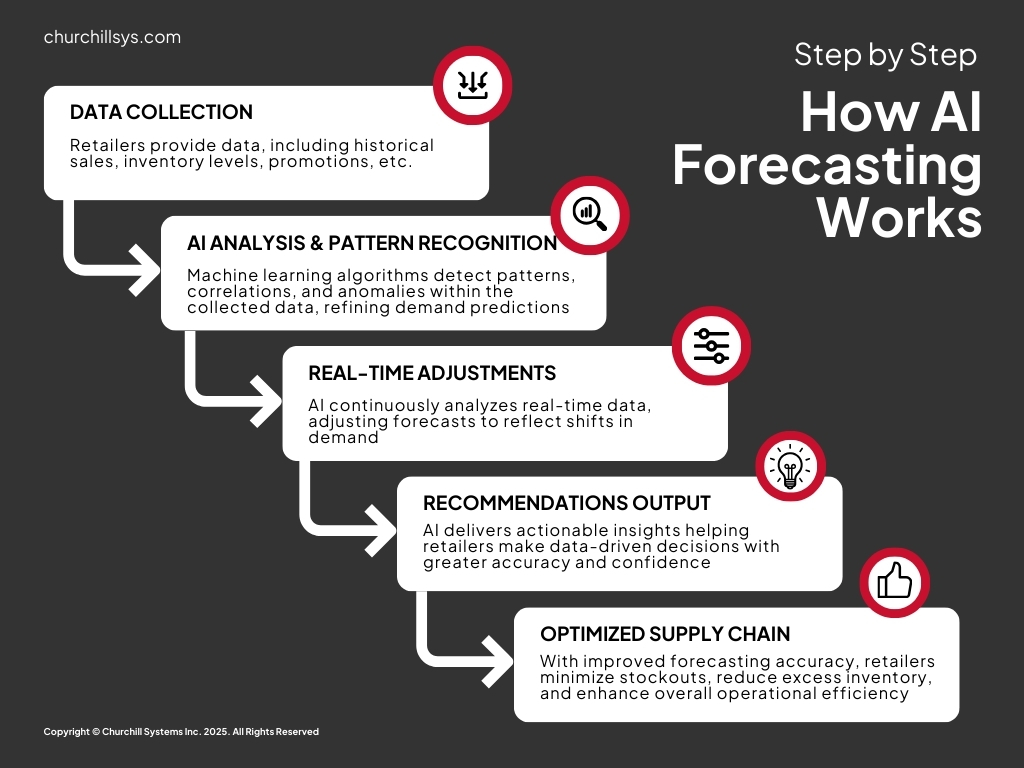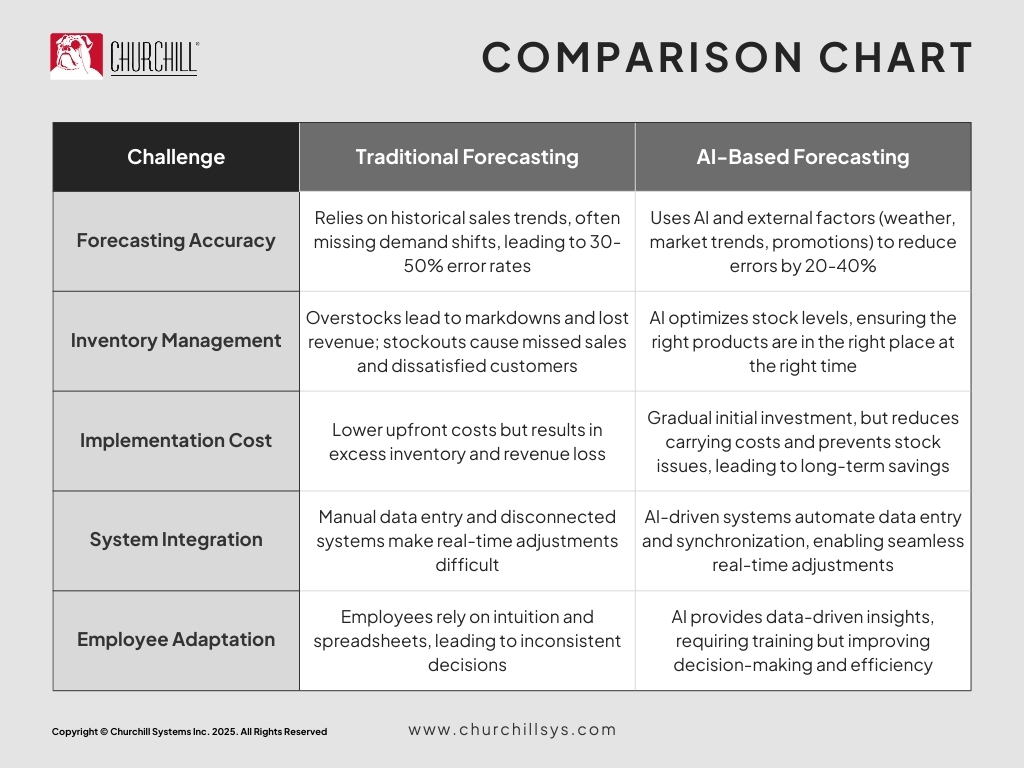Share on social
Highlights
Staying ahead of demand fluctuations is essential for optimizing Supply Chain operations. Yet, traditional forecasting methods often fall short — leading to stockouts, excess inventory, and missed revenue opportunities. These inaccuracies are especially problematic when managing seasonal shifts, product allocation, and inventory replenishment.
AI-based Demand Forecasting offers greater accuracy, reduced stockouts, and optimized inventory, yet many retailers remain hesitant to adopt these solutions.
Challenges Retailers Face When Considering AI Implementation
Despite the benefits AI can offer in Demand Forecasting, retailers often encounter various hurdles when attempting to integrate AI solutions into their operations. These challenges include:
High Initial Investment
One of the biggest hesitations for businesses adopting AI is the cost of implementation. The upfront investment in technology, integration, and personnel training is a serious financial commitment, and businesses often hesitate — despite the long-term gains in cost savings and efficiency. Churchill offers a modular approach reducing the initial investment cost.
Integration with Legacy Systems
Many AI systems providers require a total overhaul, making it difficult for retailers to integrate new solutions into their existing infrastructure. This often leads to costly disruptions and operational challenges. At Churchill Systems, we pride ourselves on a non-rip-and-replace integration model, which allows businesses to seamlessly implement AI without replacing their current systems.
Employee Resistance and Human Factor
AI implementation often requires workforce adaptation. Employees may resist AI adoption due to lack of familiarity with AI-based tools. Proper training and continuous support are essential for a smooth transition. Churchill provides ongoing hosting and support of its live applications.
Misconceptions About Data Requirements
Many retailers believe they need large, perfectly structured datasets before implementing AI, delaying adoption. The truth is, AI can work with fragmented or incomplete data — provided it is sophisticated enough to fill gaps and generate accurate forecasts. Modern AI solutions, like those from Churchill, are designed to enhance incomplete data, making AI-driven forecasting accessible even for retailers with inconsistent or incomplete datasets.
The Role of AI in Reducing Forecasting Errors
Traditional demand forecasting methods often yield higher error rates, leading to lost sales and excess inventory. AI-powered forecasting reduces these errors by 20-50%, allowing for:
- Improved inventory management with leaner stock levels
- Better decision-making for procurement and replenishment
- Optimized allocation strategies to match demand fluctuations
- Enhanced responsiveness to market changes
- Reduced markdowns and improved profitability
- More efficient workforce planning
- Stronger supplier collaboration
- Better customer experience
Here’s how AI operates in reducing forecasting errors:

Advanced Data Analysis
AI algorithms process vast amounts of historical sales data, identifying complex patterns and trends that traditional methods might overlook. This comprehensive analysis enables more accurate predictions of future demand.
Real-Time Data Processing
AI systems continuously analyze real-time data, allowing for immediate adjustments to forecasts in response to sudden market changes or unforeseen events. This agility ensures that demand predictions remain relevant and accurate.

**data from Biztech Magazine
Demand Forecasting in Different Areas of Supply Chain Operations
Accurate Demand Forecasting is the foundation of efficient Supply Chain operations. By leveraging AI-driven forecasting models, businesses can enhance their Supply Chain efficiency across multiple key areas:
Seasonality and Demand Forecasting
Consumer demand fluctuates throughout the year due to seasonal trends, holidays, regional shopping behaviors, and other factors. Traditional forecasting models often struggle to account for these patterns, leading to misaligned inventory levels.
AI-based Demand Forecasting analyzes historical sales, external factors and other events to predict seasonal shifts with higher accuracy. This allows businesses to optimize stock levels, pricing strategies, and promotional planning to maximize profitability during peak periods while minimizing waste during slower seasons.
Learn more about Seasonality in Demand Forecasting and how AI enhances seasonal demand predictions.
The Impact of AI-based Demand Forecasting on Allocation and Sell-Through
Effective product allocation ensures that inventory is distributed to the right locations based on anticipated demand. Sell-through forecasting refines this process by predicting daily or weekly demand at each store or distribution center.
AI-driven models consider factors like regional sales trends, historical purchase behaviors, and real-time demand signals to optimize allocation. This reduces markdowns, prevents stock imbalances, and ensures a steady flow of products through the supply chain, improving overall revenue and operational efficiency.
Read more about Churchill’s Allocation and Sell-Through solution.
Demand Forecasting and Inventory Replenishment
Timely replenishment is critical to maintaining optimal stock levels without overburdening stock rooms or leaving shelves empty. Demand forecasting helps retailers and suppliers anticipate when and how much inventory needs to be restocked.
AI-driven replenishment models use real-time sales data, supply chain constraints, and predictive analytics to adjust restocking schedules dynamically. This results in fewer stockouts, lower carrying costs, and improved responsiveness to shifts in consumer demand.
Explore Churchill’s Inventory Replenishment solution to see how AI-driven forecasting ensures the right products are available at the right time, minimizing stockouts and reducing excess inventory.
AI-powered Demand Forecasting is no longer a futuristic concept — it’s a necessity for retailers looking to stay ahead in an increasingly unpredictable market. By leveraging AI’s ability to analyze vast amounts of data, process real-time information, and continuously refine its predictive models, businesses can significantly reduce forecasting errors, optimize inventory management, and enhance overall supply chain efficiency.
As consumer expectations continue to evolve, businesses that invest in AI-powered Demand Forecasting will be better positioned to anticipate demand fluctuations, minimize waste, and maximize profitability.